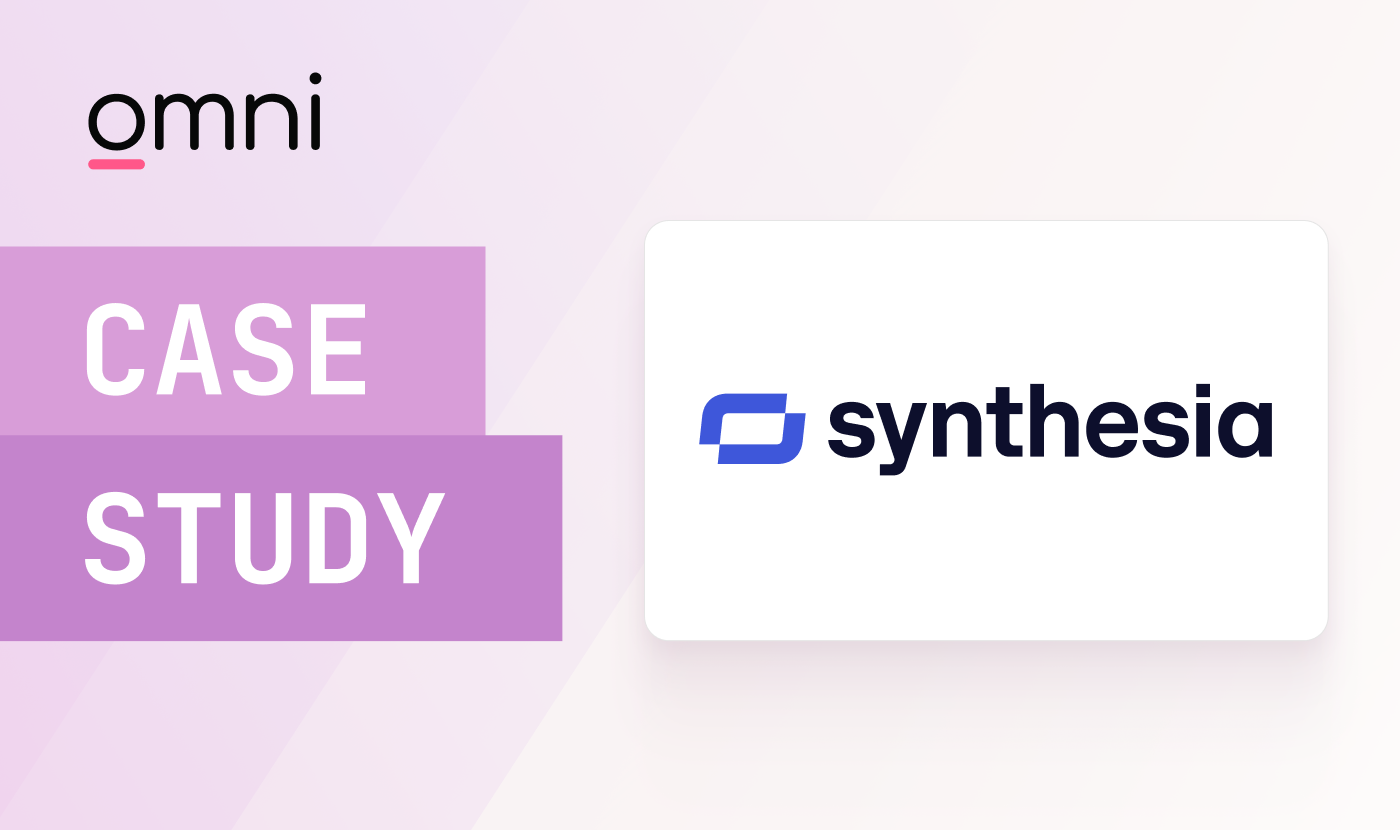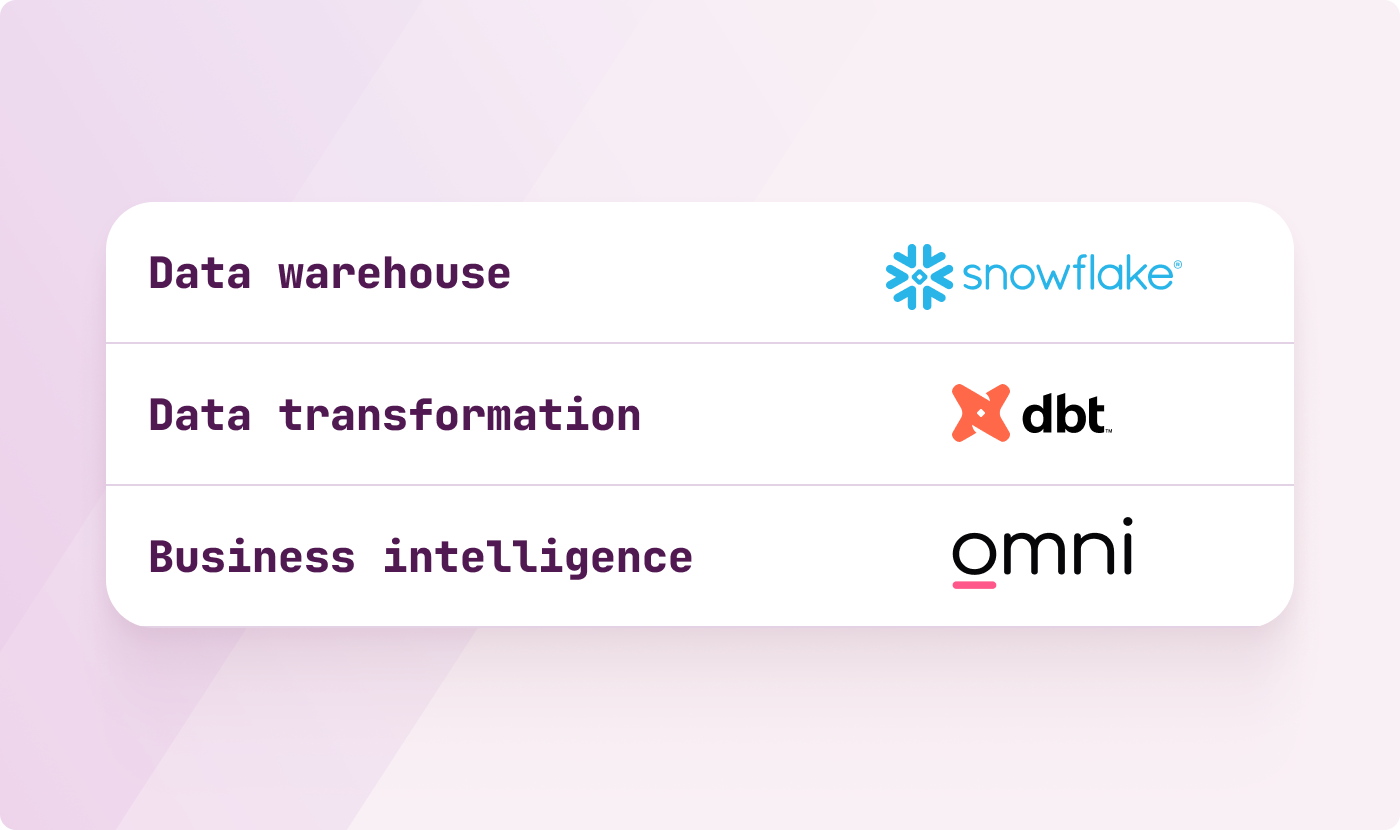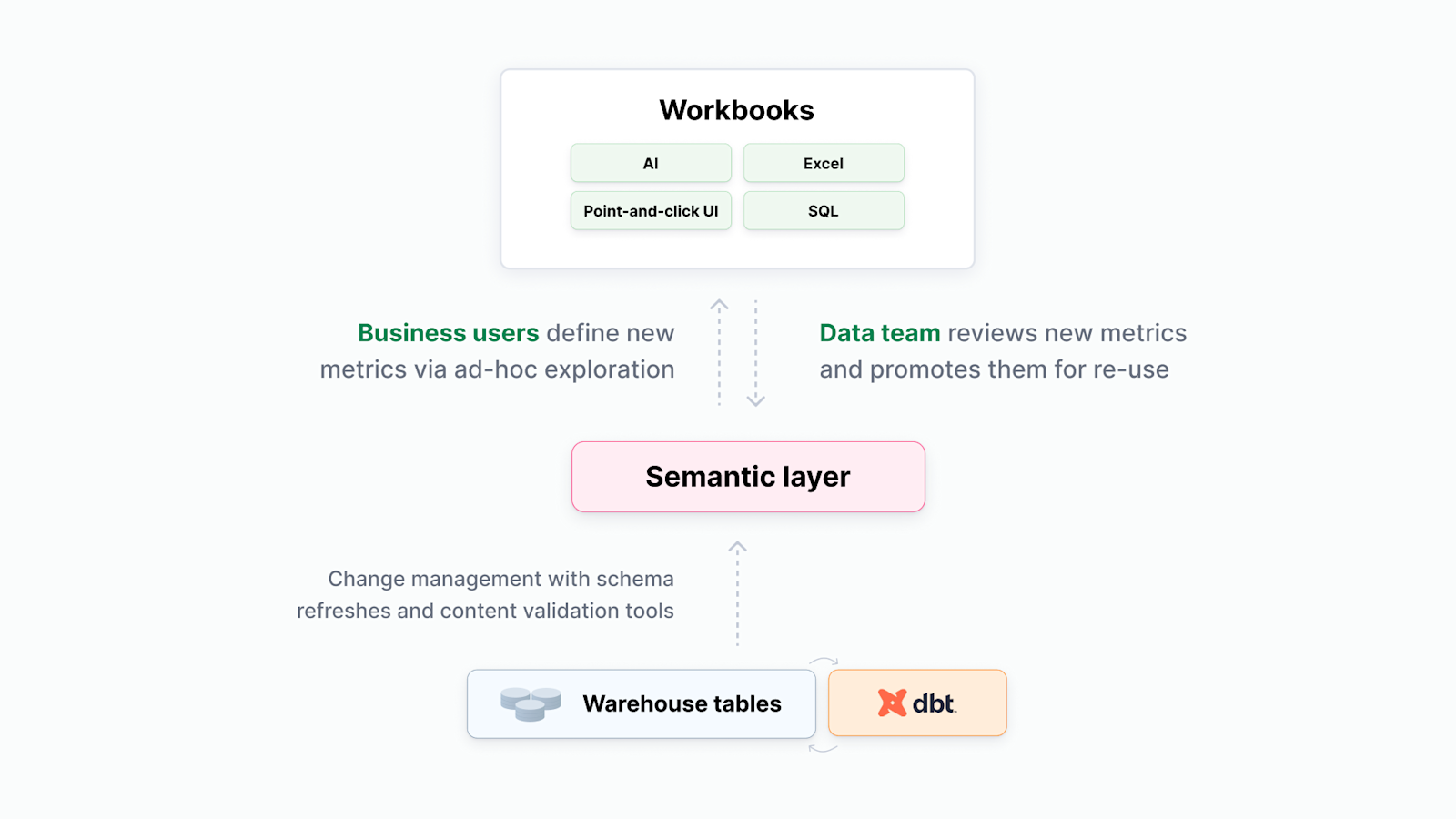
Synthesia's AI video platform helps enterprises cut production costs by up to 90% using studio-quality AI avatars and advanced video generation tools. As demand surged and the company scaled to hundreds of employees, their fast-moving culture created a critical gap. The company lacked a centralized data practice to support decision-making at scale.
When Edward Mancey joined as the first data hire, he inherited a patchwork of long, complex Metabase queries with no clear owner or standard practices. This setup made it hard for most employees to access and trust the data they needed to move quickly and make decisions confidently.
After evaluating several BI vendors, Synthesia implemented Omni to enable business teams to analyze data and build their own reporting, resulting in measurable operational efficiency across the business.
Results #
Went from vendor selection to board reporting in under 3 months — soon growing to hundreds of weekly active users
Enabled business users to define new metrics in Omni’s UI, while the data team governs and promotes them through the semantic layer to capture expertise without losing consistency
Unlocked faster & more accurate sales forecasting, driven by increased visibility into pipeline efficiency
Optimized SDR call connections & daily activities, driving higher quota attainment across regions
Utilizing AI-powered summaries to help every employee interpret dashboards & take action with confidence
Synthesia's Data Stack #

The Challenge #
When Mancey joined Synthesia in May 2024, the data environment reflected its culture of autonomy — high output and low structure. But the tangle of Metabase queries built by different teams wasn’t scaling with the business's rapid growth.
“Everything needed rebuilding,” Edward shared. “In lots of cases, there was no ETL, staging tables were full of business logic, and queries selected from 10 different sources. Even simple questions like ‘What’s our win rate?’ required digging through layers of ad-hoc logic.”
The lack of centralization led to confusion and inconsistency. Marketing and sales teams disagreed on core metrics like MQL volume and conversion rates. Business users couldn’t self-serve, and funneling all data questions through Edward would have created a decision-making bottleneck.
“I couldn’t be both the data team and the subject matter expert for every department,” said Edward. “We needed a data practice that would let people contribute and utilize their own expertise so we could keep moving fast.”
The Evaluation & Migration #
Edward started the BI evaluation process expecting a long road ahead, filled with project scoping, vendor evaluations, and a year-long implementation. But after evaluating a shortlist of platforms like Sigma and ThoughtSpot, it was a quick decision: Omni quickly stood out for its flexibility, built-in semantic model, speed of product development, and customer support.
“I had experience with semantic layers, but modeling in Omni is so much faster and lighter. Other tools make data modeling feel like extra work; Omni makes it part of the workflow and opens it up to business users so they can add business context only they know.”Edward Mancey, GTM & Ops Data Lead
As part of their Omni rollout, Synthesia decided to clean up the rest of their data stack, including rebuilding their analytics pipelines. “We migrated everything to a new dbt instance in a cleaner way. With Omni’s content validator, it was straightforward. I did it over a weekend,” adds Edward.
What Edward originally feared might take up to one year took less than three months, with Synthesia running board reporting out of Omni soon after their implementation.
The Impact #
Radical self-service and measurable business outcomes #
Omni’s layered approach to data modeling gave Synthesia a scalable structure for what Edward calls “radical self-service,” which creates clear lines of responsibility and ensures no one gets slowed down.
The data team focuses on their expertise: data ingestion and the core data model. From there, the business units control their reporting, analysis, and decision-making. Business experts even have the ability to define new metrics directly from the UI without coding expertise. These metrics can then be reviewed by the data team in a git workflow to be promoted across the entire organization for re-use. This approach keeps governance intact while letting business users move fast and contribute expertise back into the model so the entire organization can benefit from domain expertise.
“Omni flips the traditional data model workflow. Instead of the data team coding every metric definition, business users can define them directly in the UI — using Excel-style formulas or point-and-click. The data team then reviews these definitions in a git workflow, and once they’re ready, they promote those definitions across the company for reuse. It’s how we move fast without sacrificing trust.”Edward Mancey, GTM & Ops Data Lead

With consistent metrics across departments, Synthesia’s teams now align on a shared understanding of performance. Marketing and sales collaborate with a shared definition for MQLs and conversion rates, and RevOps can easily understand lead flow. Bottlenecks are easier to identify, and handoffs between teams are faster and smoother.
“Omni lets our data team get out of the way. Our business users build reports I’d never think of. By opening up the semantic layer to the business, it ends up tightly aligned to how the business actually runs. That’s the value of having a semantic layer coupled with our BI platform.”Edward Mancey, GTM & Ops Data Lead
Improving forecasting and sales execution #
With a semantic layer closely aligned to how the business operates, it’s easier for teams to build more specific, impactful reporting.
For example, a sales leader built their own dashboards to track late-stage pipeline health and surface any deals missing key steps, like contracts or approvals. “Our sales forecasting chart isn’t something that I would have known to build because sales isn't my area of expertise, but our sales team knew what they needed and they were able to build it on their own,” shares Edward.
These insights are now central to forecast calls and coaching to help leaders identify potential risks early on and improve conversion. Sales leadership also uses Omni's AI to streamline quarterly business reviews, generating analyses of each sales rep’s performance across pipeline generation, activity, and conversion. Omni’s AI summaries help managers quickly compare performance, identify strengths and opportunities for improvement, and build detailed action plans.
Optimizing SDR performance #
Synthesia’s sales leadership uses Omni to understand and optimize every step of their process.
Previously, SDR (sales development rep) success was measured by activity volume. But when an SDR leader discovered call connection rates were declining even as activity volume increased, they used Omni to understand what was actually happening. Analysis of call-level data uncovered that over-dialing the same numbers actually hurt productivity.
By building new dashboards in Omni, SDR leaders rebalanced call lists, introduced rotation logic, and prioritized leads by freshness. This visibility measurably increased connect rates and quota attainment and facilitated more focused, efficient daily activity.
“Omni helped our SDR team identify exactly where they were losing efficiency,” explained Edward. “The team leaders were able to spot patterns and adjust behavior in real-time.”
AI-powered insights for every user #
As an AI-first company, Synthesia also embraced Omni’s AI features to help every employee analyze and interpret data faster.
“Our big lesson with AI is that it’s about control. When you constrain it and give it context, like Omni’s semantic layer does, you get predictable, reliable results that drive action. Without Omni’s AI summaries, some of our biggest operational gains would have been harder to achieve.”Edward Mancey, GTM & Ops Data Lead
Edward shares, “Just as we develop AI prompts for our own product, we can give Omni instructions on which columns we want to include and how we want it to interpret our data. For example, we use AI summaries to explain to CSMs how a customer's feature usage is changing. Omni’s AI will query the correct data across product, sales, and operations, and give answers that actually recommend actions to take.”
In addition to using AI summaries, teams across Synthesia instantly started using dashboard AI within days of the feature launching. “Omni’s dashboard AI makes it much easier for our sales leaders to self-serve and answer their own follow-up questions without any additional support from our data team. It’s aligned with our overall AI philosophy, which is all about using control to create predictability,” explains Edward.
In just over a year, Synthesia evolved from a fragmented BI environment into a company-wide culture of governed self-service. With Omni, the growing data team isn’t taking tickets or slowing down the business — instead, it enables every department to move faster, understand performance, and act with confidence.